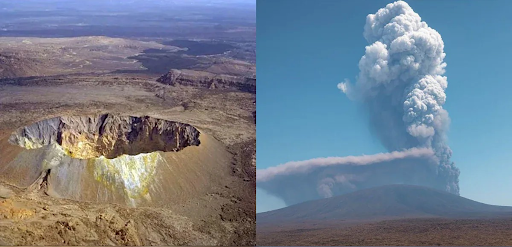




Source: WORLD ATLAS
Disclaimer: Copyright infringement not intended.
In 2024 Tanzania recorded its hottest year since 1970 with extreme nighttime warming & fourth wettest year on record, driven by El Niño & Indian Ocean Dipole threatening food security & agriculture in region.
|
Aspect |
Details |
|
Average National Temperature (2024) |
24.3°C which is 0.7°C above long-term average making it hottest year since record-keeping began in 1970. |
|
Nighttime Minimum Temperature |
19.3°C which is 1.1°C above normal highlighting a pronounced warming trend at night. |
|
Daytime Maximum Temperature |
Averaged 28.8°C which is only 0.4°C above average showing disproportionate nighttime warming. |
|
Regional Extremes |
Lake Victoria basin, northeastern highlands, northern coast, Unguja & Pemba islands +1°C to +2°C anomaly in minimum temperatures. Central, inland coastal & western regions +0°C to +1°C anomaly. |
|
Monthly Record-Breakers |
July 2024 Highest anomaly of +1.1°C above average. February Third warmest February on record since 1970 (+1.5°C above average). May, June, November Warmest ever for their respective months in 55 years. |
|
Minimum Temp Dominance |
11 of 12 months in 2024 saw minimum temperature anomalies exceed maximum temperature anomalies. |
|
Aspect |
Details |
|
Annual Rainfall |
1,307.6 mm which is 285.2 mm (28%) above long-term average making 2024 wettest year in two decades. |
|
Seasonal Rainfall (Nov 2023 – Apr 2024) |
1,354.6 mm equaling 172% of long-term average wettest seasonal total since 1970. |
|
January 2024 |
Wettest January on record particularly for eastern Tanzania rainfall over 200% of normal in many areas. |
|
April & May 2024 |
Fifth wettest April since 1970. Ninth driest May showing increased variability post wet season. |
|
Climatic Driver |
Impact in 2024 |
|
El Niño |
Strong influence in causing above-average rainfall during Nov to Apr rainy season. |
|
Positive Indian Ocean Dipole (IOD) |
Intensified wet season particularly in northeast & eastern Tanzania. |
|
Climate Trend |
Aligns with 2024 study in Nature projecting increased warm nights under RCP4.5 scenario. |
|
Area |
Impact |
|
Food Security |
Threatened due to erratic rainfall & temperature extremes especially affecting maize yield as highlighted in TMA’s 2017 projections. |
|
Livelihood Vulnerability |
80% of Tanzanians depend on agriculture making them extremely vulnerable to climate shocks. |
|
Public Health |
Nighttime heat increases risk of heat stress, vector-borne diseases & disrupted sleep cycles especially in children & elderly. |
Tanzania
|
Category |
Details |
|
Country Name |
United Republic of Tanzania |
|
Capital |
Dodoma (Official Capital since 1974) |
|
Commercial Capital |
Dar es Salaam (Largest city & major economic hub) |
|
Location |
East Africa, just south of Equator lying between 1°S & 12°S latitude |
|
Coordinates |
6°18′ S, 34°51′ E |
|
Bordering Countries |
North Kenya, Uganda |
|
Total Area |
945,087 sq km (13th largest in Africa) |
|
Coastline |
Indian Ocean 1,424 km of coastal stretch |
|
Major Islands |
Unguja (Zanzibar), Pemba, Mafia Island |
|
Feature |
Details |
|
Highest Point |
Mount Kilimanjaro 5,895 m (World’s tallest free-standing mountain; dormant stratovolcano) |
|
Lowest Point |
Indian Ocean coastline Sea level |
|
Major Plateaus |
Central Plateau semi-arid, 1,000 to 1,500 meters elevation |
|
Volcanic Features |
Ngorongoro Crater, Ol Doinyo Lengai (active volcano) |
|
Water Body |
Details |
|
Lake Victoria |
Largest lake in Africa; shared with Kenya & Uganda |
|
Lake Tanganyika |
World 2nd deepest lake, longest freshwater lake in world; biodiverse |
|
Lake Nyasa (Malawi) |
Third largest in Tanzania; known for cichlid diversity |
|
Major Rivers |
Rufiji (largest river system), Ruvuma, Pangani, Malagarasi, Wami, Kagera |
|
Hydropower Dams |
Mtera, Kidatu, Kihansi & planned Julius Nyerere Hydropower Station (on Rufiji) |
|
Agricultural Dependency |
Over 80% of population relies on agriculture |
|
Major Crops |
Maize (staple), cassava, rice, coffee, tea, cotton, sugarcane, cashews |
|
Impact of Climate Change |
Erratic rains, warming nights & droughts threaten maize yields, crop cycles & food security |
|
Major Ecological Zones |
Serengeti Plains, Eastern Arc Mountains, Miombo Woodlands, Coastal Forests & wetlands around Lakes Victoria & Tanganyika |
|
Conservation Zones |
17 national parks (Serengeti, Kilimanjaro, Tarangire), Ngorongoro Conservation Area, Selous Game Reserve |
|
Climate Vulnerability |
Coastal areas sea level rise risk |
|
Population (2024) |
~67 million |
|
Urbanization Rate |
~37% (fast-growing cities like Mwanza, Arusha, Mbeya, Dar es Salaam) |
|
Languages |
Swahili (official), English (co-official), over 120 local languages |
|
Religion |
Christianity (~61%), Islam (~35%), Indigenous beliefs |
|
Climate Risk Impact |
Affects livelihoods, displaces rural populations, increases vector-borne diseases, threatens water & food security |
For more such articles, please visit IAS GYAN
Sources:
|
PRACTICE QUESTION Q.Discuss impact of climate change on Tanzania agricultural productivity & food security with reference to 2024 climate anomalies. |







© 2025 iasgyan. All right reserved